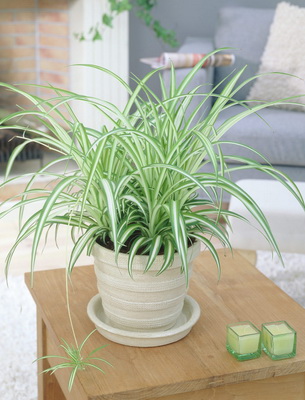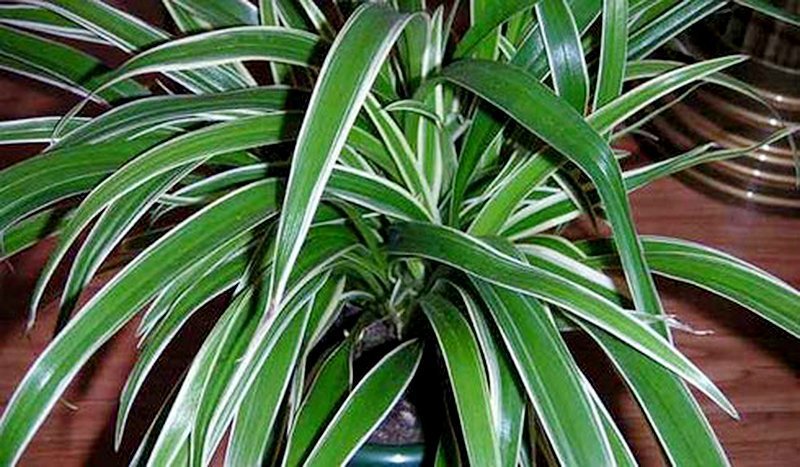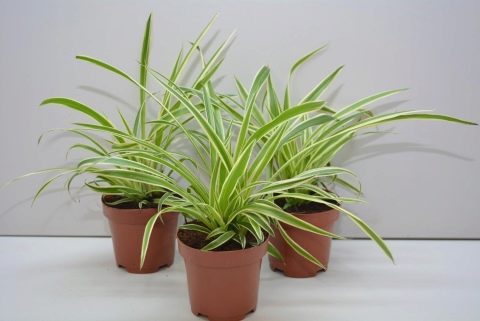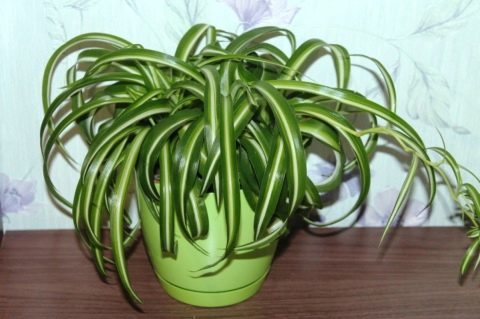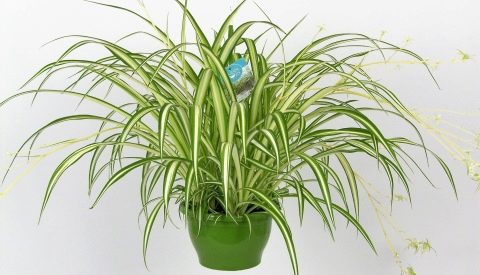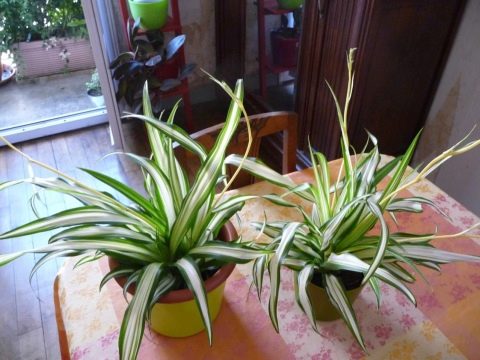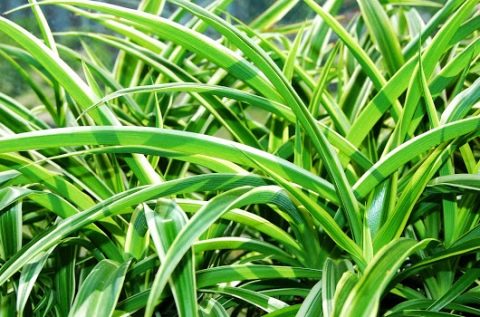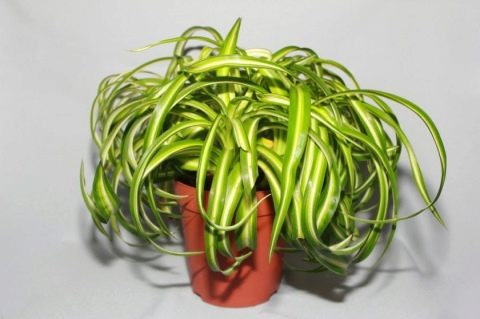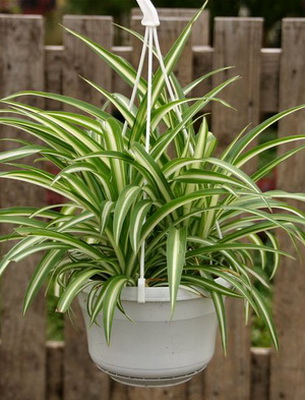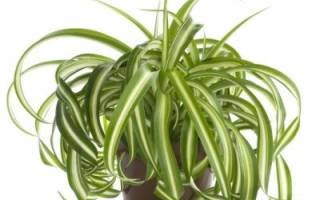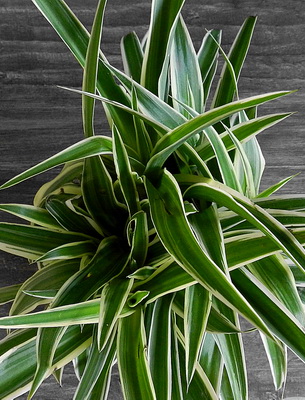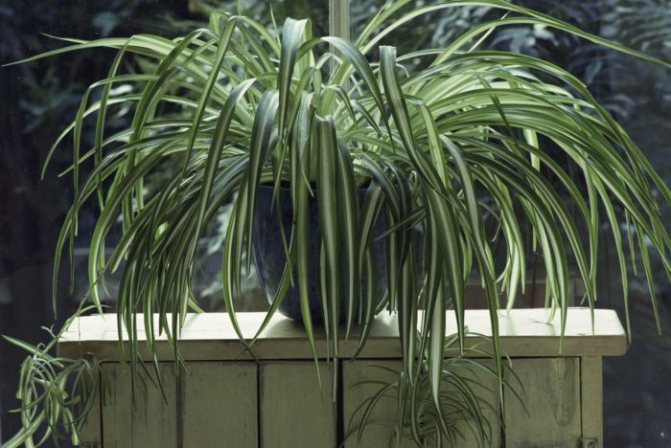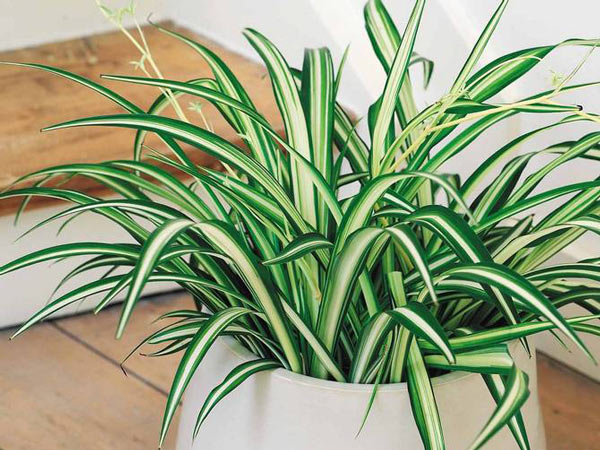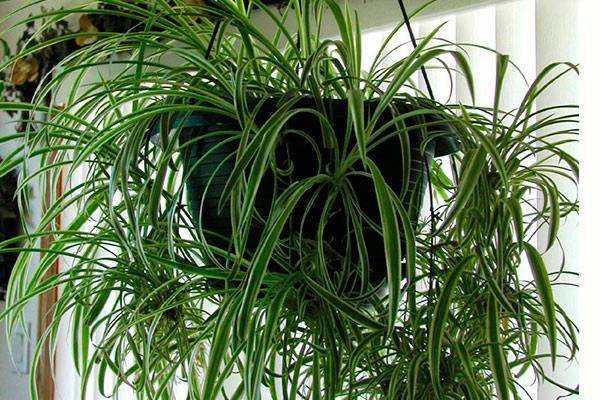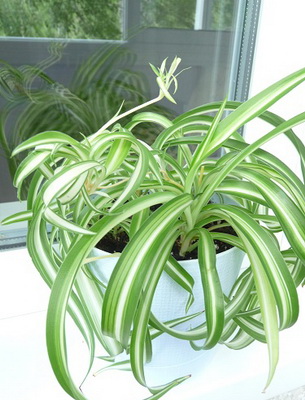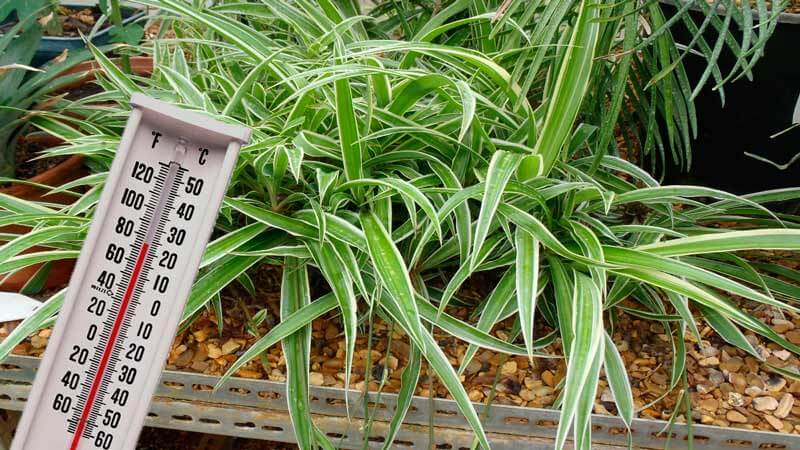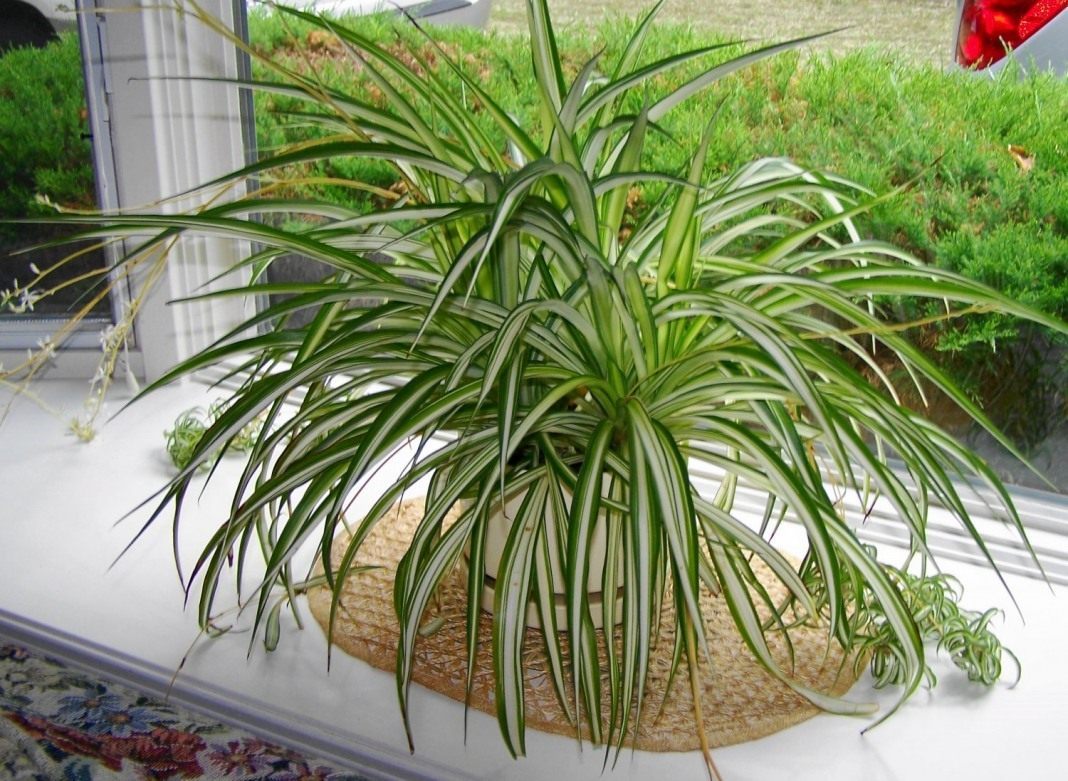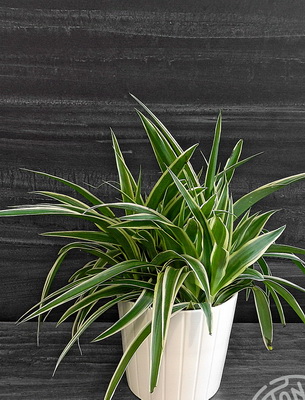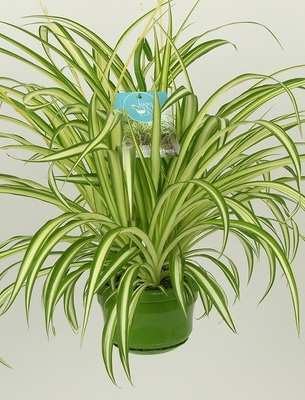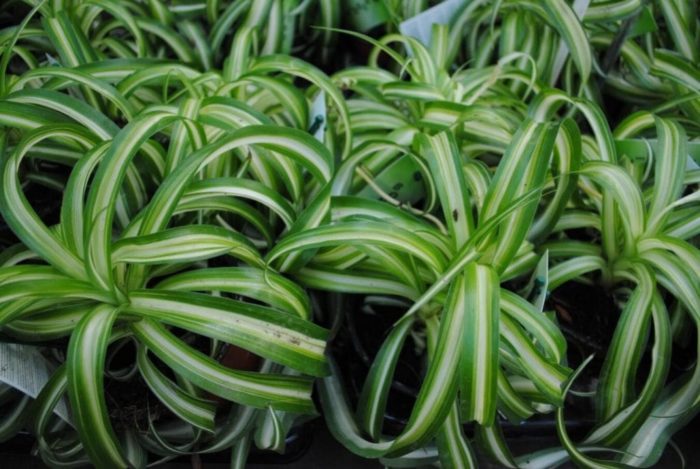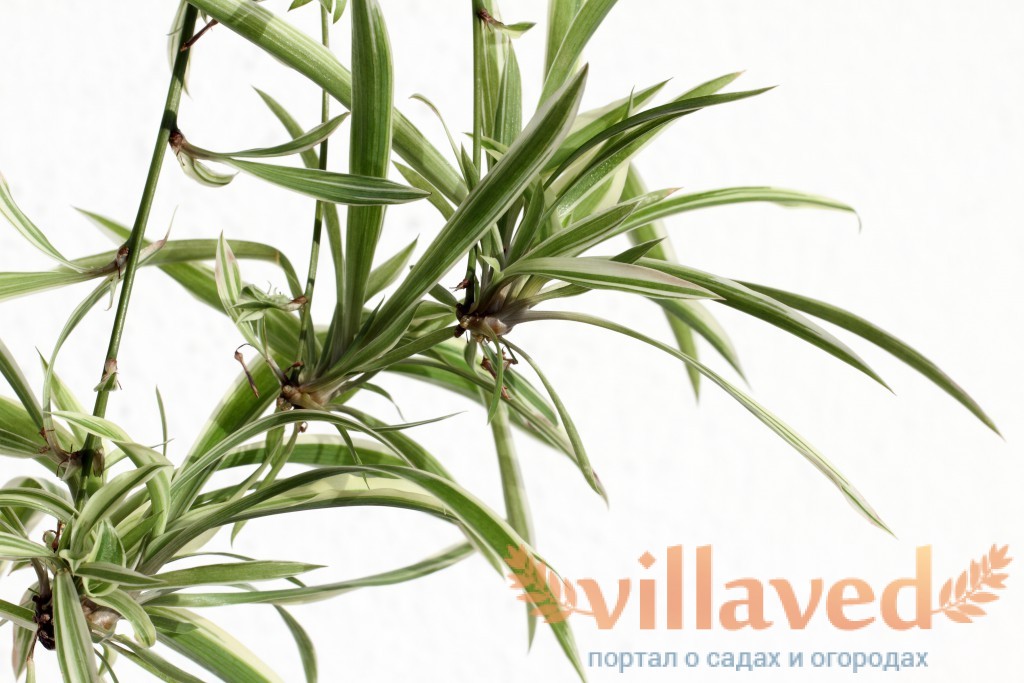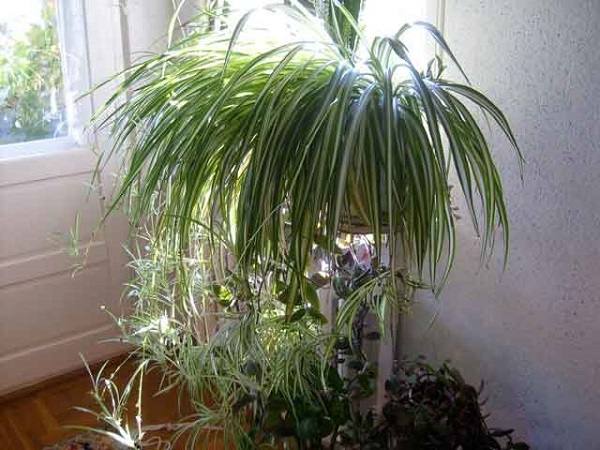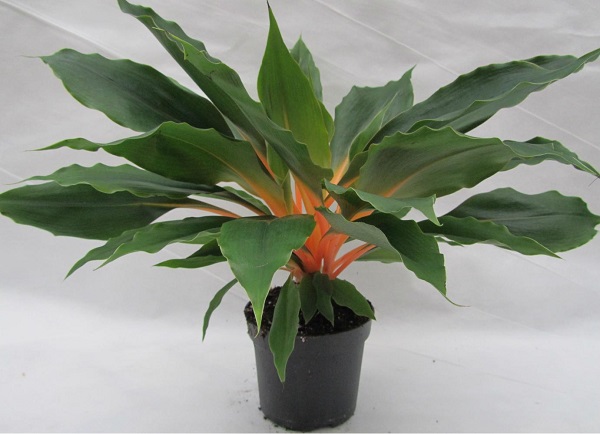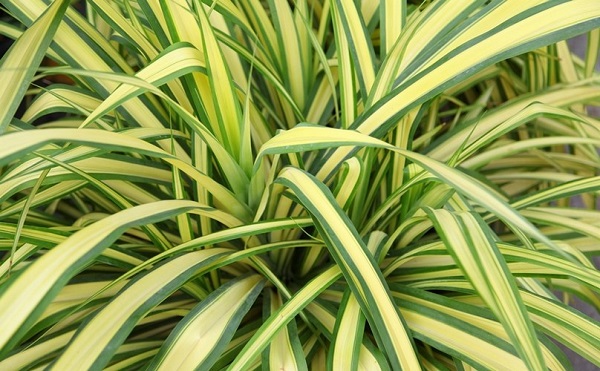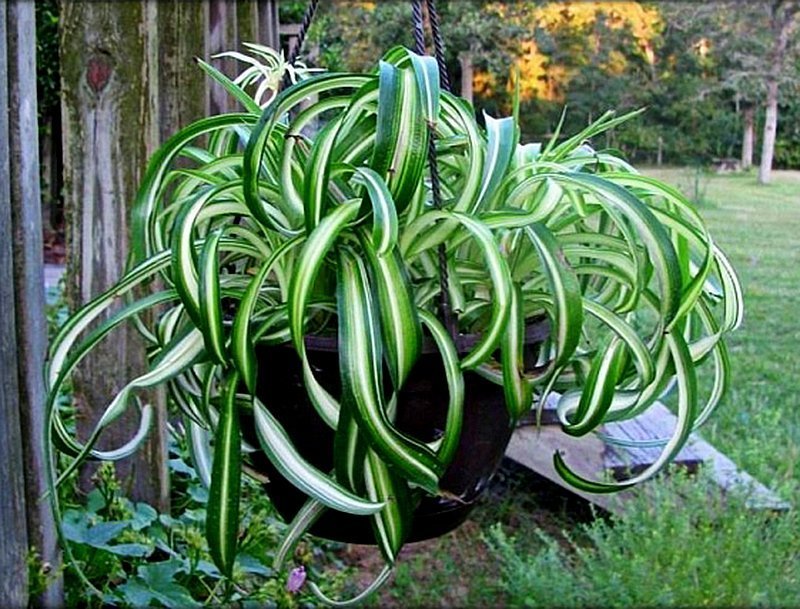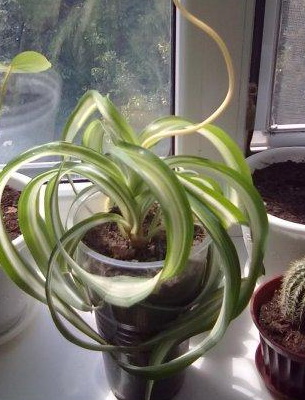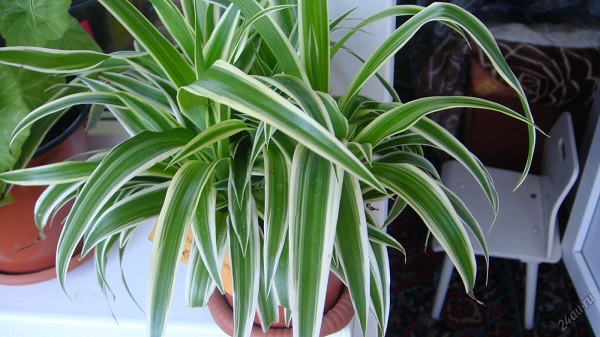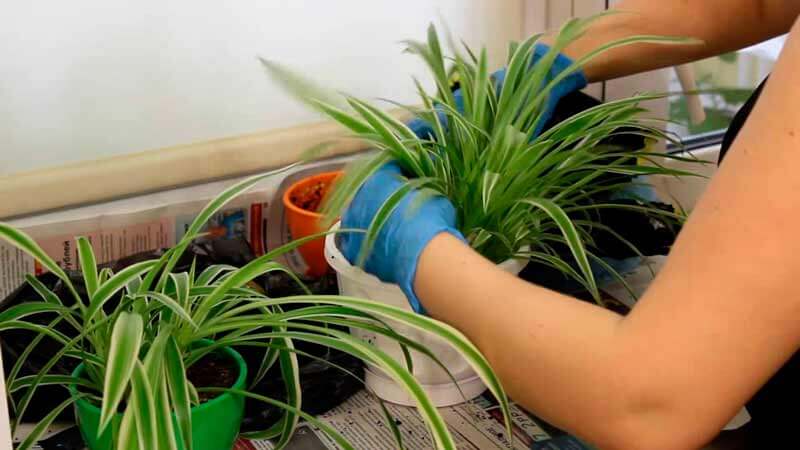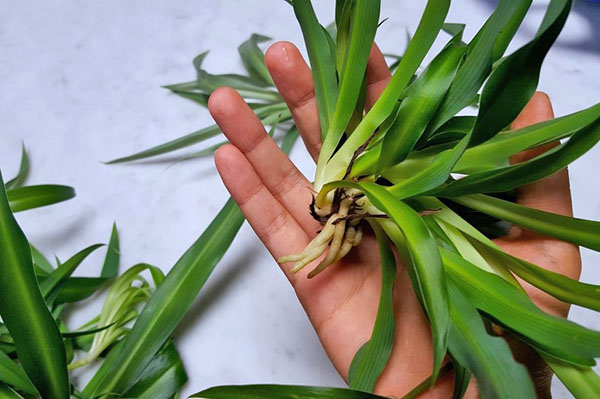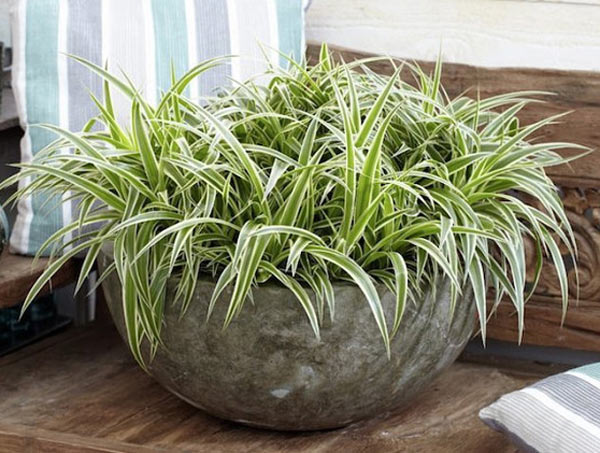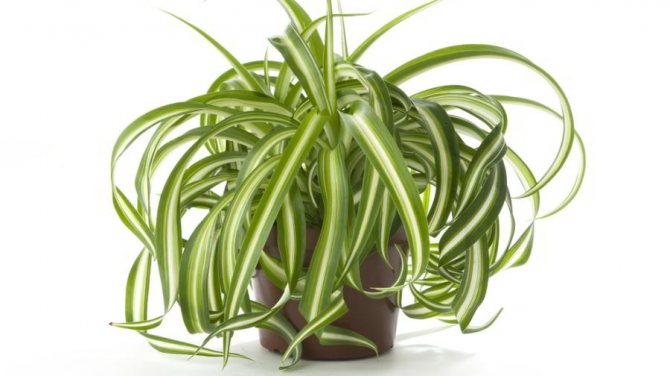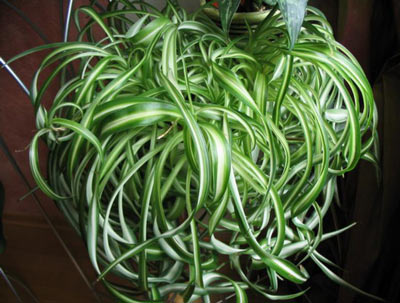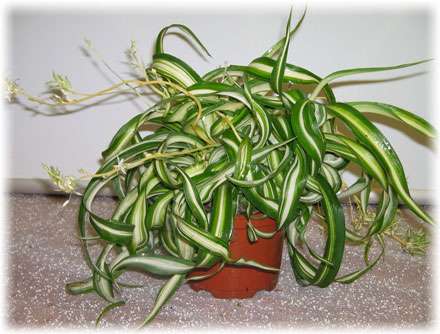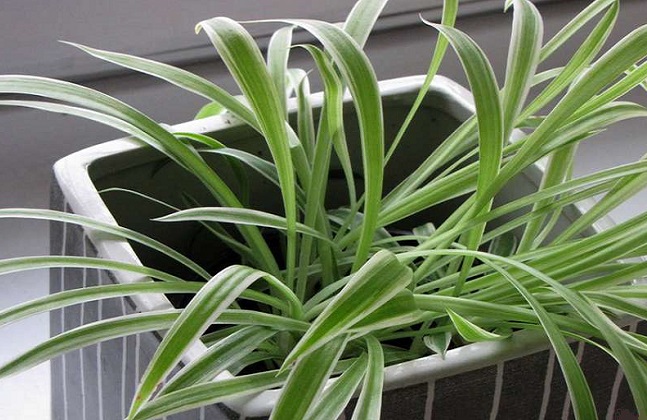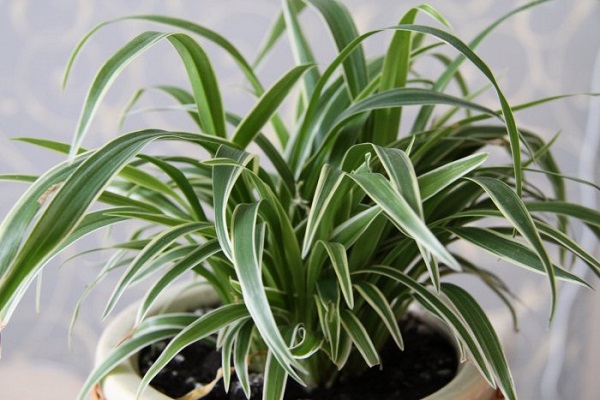Description of the flower chlorophytum crested with photo
We offer you a description of the chlorophytum crested flower. In an apartment, the plant grows to about 60 cm in height. It also has fleshy, deep roots, about 10 cm in depth. Leaves are usually very long, up to 50 cm, and narrow - no more than 30 mm.
The flowers grow on a long, branched inflorescence that can grow up to one meter in height and at the end bends downward. Flowers can grow from one to six in each cluster, which are located along the stem at well-defined intervals. Towards the end of the inflorescence, each cluster becomes smaller in size. Usually the first flowers fall off, so you rarely see a blooming inflorescence.
Individual flowers, which stand on pedicels up to 8 mm long, can be green or white. Each flower has three- and six-veined leaves with a small hood or in the form of a boat, which reach a height of up to 10 mm. The stamen contains pollen, producing another flower about 3.5 mm in length and filaments of about the same length. The central carpel is 3 to 8 mm long. The seeds are produced in a 3-8 mm capsule on stems that give them 12 mm in length.
The inflorescences bear sprouts at the tips, which eventually hang down and touch the soil. The stems from the inflorescence are called "stolons" in some sources, but still scientists believe that it is more correct to use this term for stems that do not bear flowers and have roots at the nodes (one of the two main structural axes of the plant, the other root; the stem is divided into nodes and internodes).
Look in all its diversity crested chlorophytum in the photo: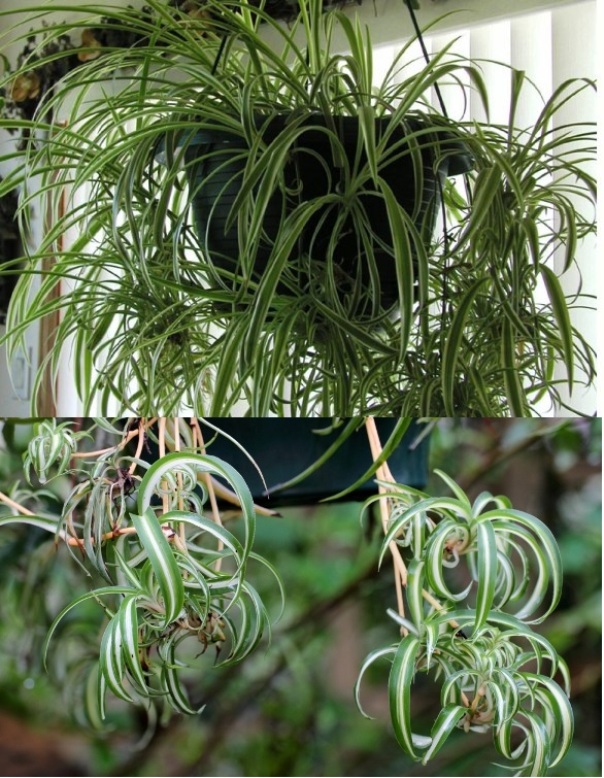
Types with photo and name
Chlorophytum crested
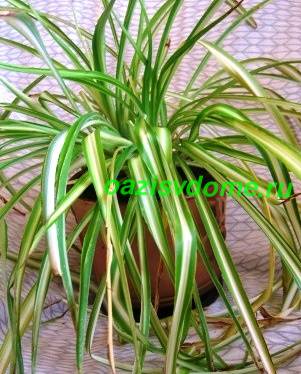 Photo of chlorophytum crested
Photo of chlorophytum crested
The most common type in indoor floriculture is distinguished by narrow, long green leaves, along the edges of which there are longitudinal light stripes. A leaf rosette is formed from the foliage, the diameter of which reaches about 50 cm. Crested chlorophytum blooms with white small flowers, instead of which, after flowering, children are formed in the form of small rosettes. They are located around the leaf rosette on long arrows, which makes the bush look like a fountain.
Popular varieties of chlorophytum crested:
- Ocean is a plant with variegated leaves that are arranged in a spiral;
- Laxum - the variety is distinguished by variegated leaves arranged in a fan shape, along the edge of which there is a white strip;
- Variegata - the light leaves of the plant are distinguished by a silvery edging;
- Vittatum is a variety with dark green leaves with a white stripe in the center.
Chlorophytum winged or orange
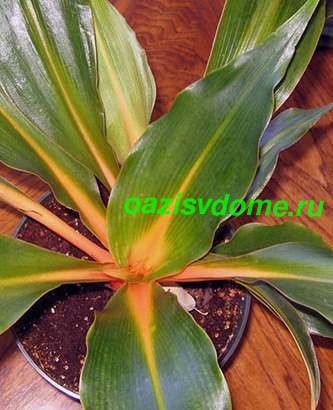 Photo of winged or orange chlorophytum
Photo of winged or orange chlorophytum
A perennial with oval wide leaves located on fleshy small petioles has a height of 30 to 40 cm. The whole beauty of the plant lies in the fact that the orange petioles and central vein contrast beautifully with the dark green leaves. During flowering, a short peduncle forms with an ear-like spike-shaped inflorescence.
Chlorophytum Cape
Photo of Cape Chlorophytum
The plant with leaves up to 60 cm long is distinguished by a monochromatic light green foliage, unattractive flowers and short peduncles. The Cape species reproduces by dividing the bush, since it does not form daughter rosettes.
Chlorophytum curly or Bonnie
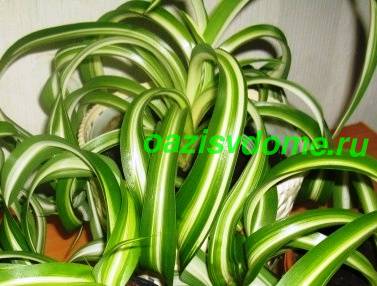 Photo of curly chlorophytum
Photo of curly chlorophytum
A beautiful compact plant with leaves twisted in a spiral. The bush also looks beautiful due to the fact that a contrasting white stripe runs along the central vein of each leaf.
The described types and varieties of chlorophytum are the most popular among flower growers. In total, about 200 species of this beautiful plant are known.
Chlorophytum care
Lighting.Chlorophytum is a rather unpretentious plant, and it is not difficult to grow it even for beginner gardeners. It feels best in a light or slightly darkened place. It can be attributed to both sun-loving and shade-tolerant plants, but in the shade of variegated forms, the bright color of the leaves is lost. For several hours a day, it transfers direct sunlight.
Temperature. It tolerates a fairly wide range of temperatures; in summer, chlorophytum can be taken out into the open air, but it should be positioned so that the place where it stands is protected from wind and rain. In winter, it is advisable that the room temperature does not drop below 10 ° C.
Watering. It is watered abundantly from spring to autumn, since chlorophytum needs a lot of moisture during the growing season. With a lack of water, forms numerous tuberous thickenings. In winter, watering is reduced, making sure that the substrate does not dry out between waterings.
Chlorophytum can tolerate dry air, but regular spraying has a positive effect on the plant.
Fertilizer. Chlorophytum responds well to feeding, especially in spring. During the growing season, they are fed 2 times a month with mineral and organic fertilizers.
Transfer. Chlorophytum is transplanted in the spring: in February - March, young annually, adult specimens in 2-3 years. The roots of chlorophytum grow strongly, so it is necessary to take wide dishes
When transplanting, be sure to pay attention to the roots of the plant: if it has formed quite a lot of large tuberous thickenings on the roots, this indicates irregular watering. The plant is transplanted into a substrate with soil acidity close to neutral (pH 6-7.5), light, loose
It is composed of sod, leafy, humus earth and sand (2: 2: 2: 1) or sod, leafy earth and sand (3: 2: 1). Good drainage is essential.
Reproduction. Chlorophytum is propagated by seeds (although this is not the most frequent method), dividing large specimens and rooting daughter rosettes with aerial roots. Seeds are often propagated by winged chlorophytum (Chlorophytum amaniense), other types of chlorophytum are easier to propagate by rooting air suckers or dividing a bush
It is better to propagate by seeds in spring (end of February - March). Sow in a light substrate (peat + sand, leafy, humus earth + sand or other light and air- and moisture-absorbing substrates). They can be pre-soaked in water for 8-12 hours or 12-24 hours, but the water must be changed regularly. The seeds are distributed over the surface evenly, slightly pressing them into the soil, the substrate is pre-moistened. Then the container with seeds is covered with a glass jar, glass or a bag, but so that it does not touch the soil. Bottom heating is used, the temperature should not fall below 21C. Seed germination time can be from 3 weeks to 1.5 months. Care comes down to regular spraying, ventilation and temperature maintenance. When the seeds germinate, they are gradually accustomed to open air, for this they are opened for a few minutes. When two or three leaves appear in seedlings, they are dived one at a time into small pots. When the seedlings grow up, they are planted in a substrate suitable for growing chlorophytum.
Air suckers can be rooted in water or substrate, separated from the mother plant. A heavily overgrown plant can be halved.
1. Seven Secrets of Success:
| 1. Growing temperature: All year long can be grown at room temperature ranging from 18 to 22 degrees Celsius. |
| 2. Lighting: variegated chlorophytum needs 2 - 3 hours of direct sun in the morning and evening, green-leaved plants are successfully grown in partial shade. |
| 3. Watering and air humidity: in spring and summer, water so that the topsoil dries slightly between waterings, in autumn and winter, the frequency of watering is reduced, and only soft water is used for watering. The air humidity does not need to be increased. |
| 4. Features: very common undemanding plant conditions. |
| 5. Soil: Chlorophytum easily tolerates a very wide range of soil conditions and can adapt to almost any substrate. |
| 6. Top dressing: in spring and summer 2 times a month with mineral and organic fertilizers.In the winter months, the frequency of fertilizing can be reduced to 1 time per month or stopped altogether before the onset of spring. |
| 7. Reproduction: sowing seeds in spring, small daughter rosettes in spring and summer, dividing adult large bushes when transplanting, |
Botanical name: Chlorophytum.
Family
Chlorophytum home - the birthplace of the plant. The flower originates from South Africa.
What it looks like. Chlorophytum is one of the most common monocotyledonous plants in indoor culture.
Leaves are green, linear, 20 - 40 cm long, gracefully curved, with parallel venation, collected in basal rosettes. Variegated varieties are distinguished by longitudinal white stripes on the leaves.
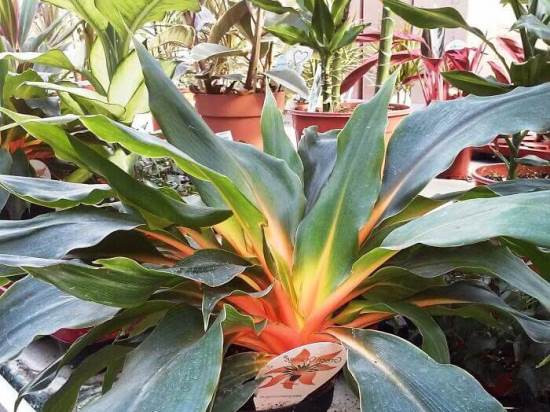
The flowering of chlorophytum is not of particular interest - the flowers are inconspicuous, white, with long yellow stamens, located on long peduncles. When pollinated, some flowers form fruits - seed pods.
After flowering, daughter leaf rosettes develop on the peduncles.
The root system of the plant is equipped with small light bulbs, which serve to store moisture and nutrients.
Periodically, the plants form long hanging stolons - whiskers with small daughter rosettes of leaves.
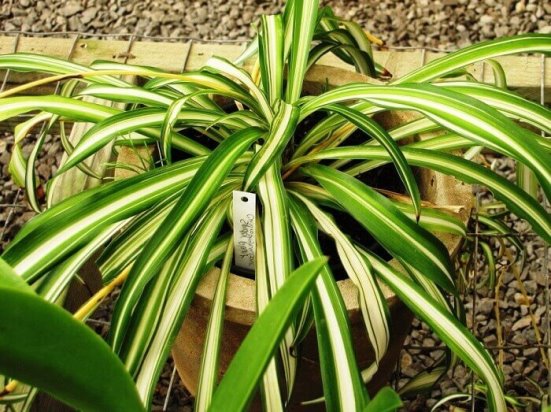
Dimensions. Chlorophytum flower usually reaches a height of 25 - 50 cm, grows rapidly.
The final size of the plant will depend on the species.
Chlorophytum types
Only a few types of chlorophytum are grown at home. These include:
Curly chlorophytum. In appearance, it looks like an ordinary grass bush, but at the same time it has large, long and wide leaves. They can be light green or dark green in color with pronounced stripes. If you properly care for this type of chlorophytum, then it begins to bloom in early spring, and bloom lasts until the end of summer. At the same time, simple inflorescences are formed, resembling panicles in appearance.
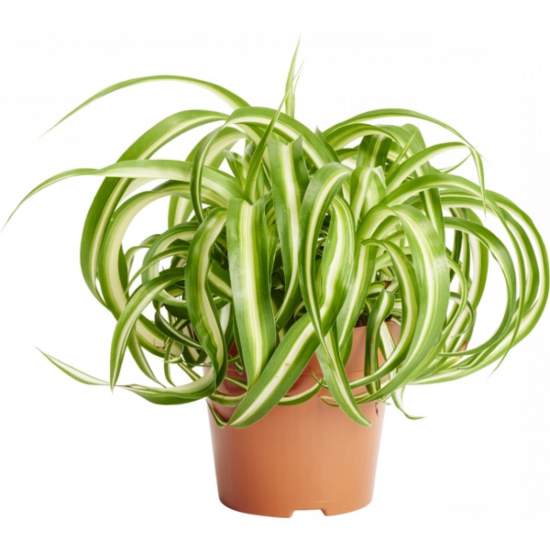
Chlorophytum Curly
Crested chlorophytum. This species is represented by a herbaceous perennial. It has a short stem on which lanceolate leaves with unusual and interesting curves grow. They are light green in color. From a bunch of leaves, shoots appear, equipped with small flowers that have a white color and the shape of an asterisk. Young plants emerge from the leaf axils. The roots are dense and white.
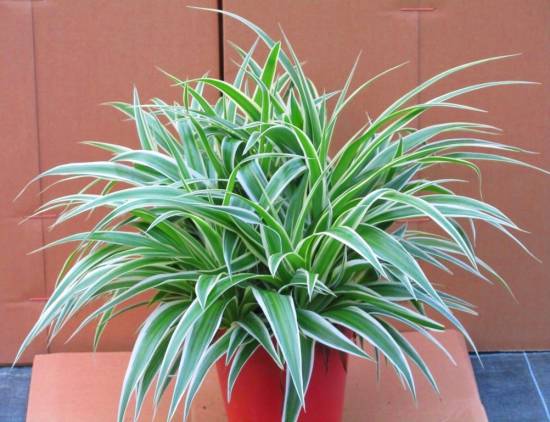
Chlorophytum crested (Chlorophytum comosum)
Orange (winged, orchidostellar) chlorophytum. It has unusual and beautiful dark green leaves growing on petioles of considerable height. The leaves are grooved, and at the stem and at the top they are tapering. To maintain the unique color of the plant, regular stem removal is required.
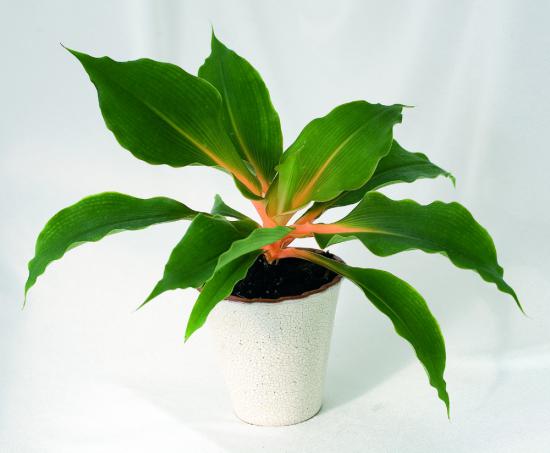
Chlorophytum orange (Chlorophytum amaniense)
Kapsky. This type of chlorophytum is a rosette perennial. Its roots resemble ordinary tubers in appearance. The leaves are lanceolate and also have a light green color. There is a groove on the outside of the leaves, and a keel inside. With proper care of the plant, it can even reach a height of half a meter. From the leaf sinuses, racemose inflorescences grow.
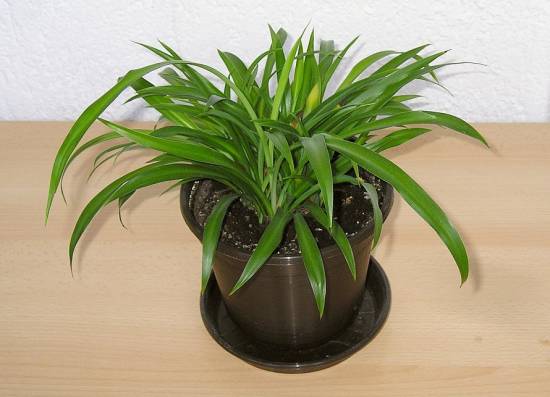
Cape Chlorophytum (Chlorophytum capense)
Important! If Cape Chlorophytum is chosen, then growers should remember that this species does not form daughter rosettes.
Watering, moisture and fertilization
Normal watering of chlorophytum is 2-3 times a week in summer, in winter - no more than 2-3 times a month (in cool rooms). The soil in the flowerpot should always be moderately moist: you should not allow the soil to dry out, but you do not need to fill the plant either. Each subsequent watering is carried out after the topsoil dries up. Water - warm, soft, preferably, settled for about 2 days. The liquid that has drained into the pan must be removed so as not to provoke a fungal disease and rot.
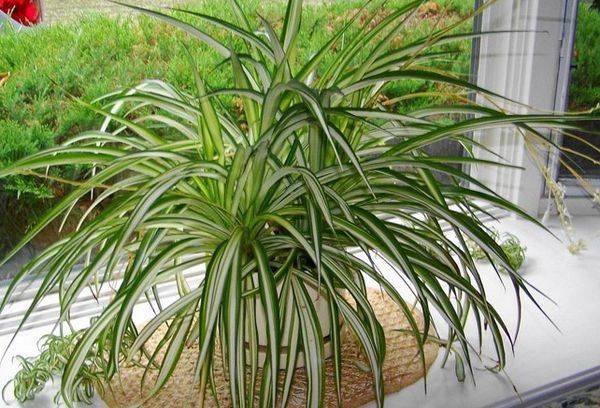
Maculatum
Chlorophytum reacts negatively to low air humidity. In dry rooms, it is recommended to periodically spray the plant and increase the amount of water for irrigation.
The plant will be grateful if you wipe the dusty leaves with a damp sponge.
This must be done very carefully so as not to damage the fragile sheet plate. If you are afraid, then substitute the bush under a light shower, after covering the ground
Top dressing is done in spring and summer during the period of active growth. In winter, the plant does not need fertilizers. Ordinary liquid mineral complexes will do. Fertilizer is applied 4-5 hours after the main watering. The frequency of feeding is once a week.
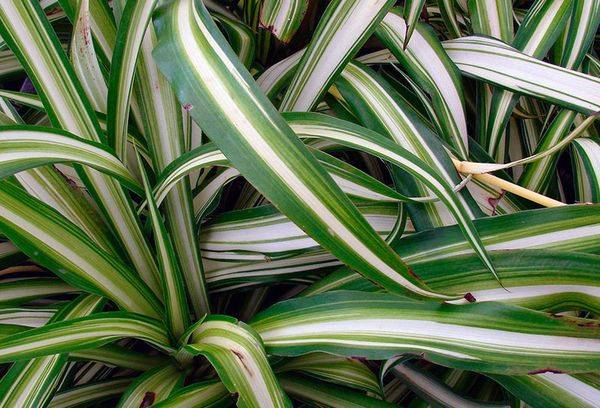
Chlorophytum Vittatum
Description
Chlorophytum is a genus of herbaceous plants. Their appearance is a rosette of oblong leaves, which, as they grow, take on a decorative appearance. He fell in love with flower growers for his unpretentious nature and beautiful leaves that look beautiful with proper watering. The homeland of the plant is Africa and its southern part.
Several years ago it was difficult to find a Russian apartment or house that did not contain at least one pot with this plant. The most famous names among flower growers are "spider", "bride veil" and "green lily". Chlorophytum began its existence in 1794 in South Africa. Only 40 years later, the plant was imported to Europe, from where the plant's rapid popularity came from.
Most of all, chlorophytum has taken root in Holland. Residents considered it a tradition in every home to have at least one plant with beautiful stems that gracefully hang down from the pots. Hence, a new name for the species appeared: "The Flying Dutchman", which owes its origin to the inhabitants of Holland.
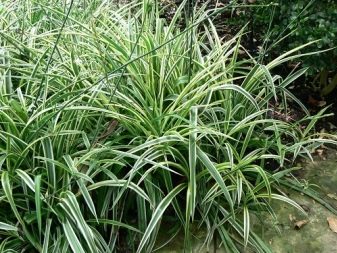
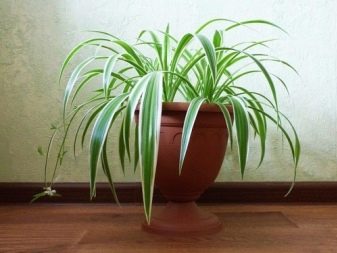
Before domestication, species had the tendency to settle in the forks of branches, rooting in cracks in the bark of trees. The stem has a rooted structure and most often white stripes that adorn it from beginning to end. The oxygen that the plant produces through the process of photosynthesis is distributed throughout the room and improves the saturation of the air. Most chlorophytums in their structure resemble fireworks: the rosette is designed in such a way that the shoots grow in different directions, forming a circle of stems, which, as they mature, go down.
Chlorophytum is so widespread that it is difficult to name the exact number of its varieties: this number ranges from 200 to 300. In addition to its decorative use, the plant is also used to purify the air.

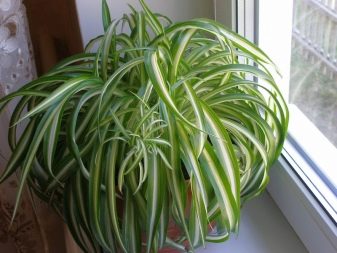
In the course of scientific research, the properties of chlorophytum to purify the air have been confirmed. It was for this reason that such plants began to flicker on space expeditions: the astronauts were allowed to take this living organism on board. Later, this decision had to be abandoned due to the fact that care takes time and additional equipment on the way, and the living conditions of the plant were at a low level due to artificial lighting.
There was no big excitement around this news, but the fact remains: the plant produces pure oxygen in the process of photosynthesis to ensure its vital activity.

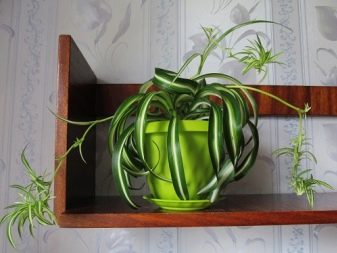
Florists love chlorophytum for the following reasons.
- Unpretentious care. It is enough to water it in a timely manner and check the leaves for possible diseases.
- Indoor chlorophytum species have a powerful ability to cleanse the atmosphere. It is not just that they try to keep the plant near the children's room or in the kitchen: the air in the nursery will be cleaner, and in the kitchen unfavorable substances will leave the gas stove.
- The variety of varieties will impress even the sophisticated plant lover. Recently, many amazing varieties of chlorophytum have been bred.
Due to the above reasons, chlorophytum has spread as part of the home garden, and today the plant can be seen in almost every home where flowers are grown.
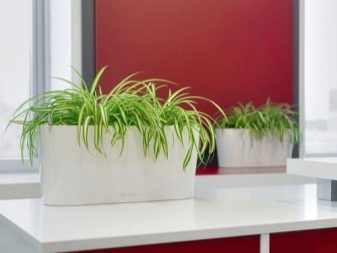
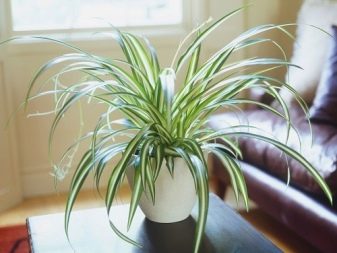
Care
Chlorophytum crested is a very undemanding indoor plant that survives in many situations. However, there are a few things to keep in mind to create a healthy habitat for your plants. Care suitable for this species ensures that Chlorophytum crested will thrive and multiply for decades.
 Chlorophytum crested (Chlorophytum comosum)
Chlorophytum crested (Chlorophytum comosum)
Place for placement
An unpretentious plant feels comfortable in a bright place. Ideal locations are where chlorophytum comes into direct contact with the sun in the morning or evening. Sunlight helps the plant grow better. However, chlorophytum should not be exposed to the hot midday sun in summer.
A partially shaded area is also a good option. However, the plant grows more slowly in dark places and shade. Low temperatures also slow down growth. Chlorophytum thrives best when the room temperature is as constant as possible, between 14 ° C and 18 ° C. It usually withstands temperatures between 10 ° C and 30 ° C.
Chlorophytum crested should be placed indoors and not outdoors, especially during cooler months. In summer, it also thrives on a balcony or garden, as long as it is not constantly exposed to direct sunlight.
Warning: Chlorophytum is a popular target for cats. They love to nibble on its long leaves.
Substrate
Suitable as a substrate for chlorophytum:
- usual soil for flowers;
- compost-based potting soil;
- homogeneous peat-clay soil.
The substrate should have a pH of 6 to 7, meaning it should be slightly acidic or neutral.
Transfer
Chlorophytum's dense and fast growing root ball requires a lot of space, so the plant should be placed in a pot or hanging vase with ample space. There should be an area 2 to 3 cm thick between the roots and the edge of the pot, filled with soil.
As soon as roots become visible, which displace the substrate to the surface or even damage the pot, chlorophytum should be transplanted into a large pot as soon as possible, regardless of the season.
Watering
Chlorophytum crested must be watered regularly with plenty of water. The ground can be constantly slightly damp, especially from spring to autumn. However, waterlogging should be avoided. Therefore, it is best to plant the plant in a pot with a drain hole. In this case, the water is removed a few minutes after watering.
A green plant can store water in its thick roots, so it is able to withstand short dry periods. However, such periods should not take too long and should not be repeated too often. From the tips of dry leaves, pest infestation and light-colored wilted leaves, you can quickly see that the chlorophytum is lacking in water.
Brown leaf tips can also indicate indoor humidity is too low. It should be between 50% and 70%. If the air humidity is too low, it is necessary to regularly spray the plant with water.
Fertilizer
Chlorophytum care also includes supplying the plant with nutrients. Targeted fertilization stimulates the overall growth of plants, resulting in the formation of new leaves and numerous shoots. However, the overall nutrient requirements of Chlorophytum are quite low.
During the main growing season, which lasts from March to September, it is recommended to add a little liquid fertilizer to the soil every two to four weeks. The main soil fertilization should be between 1 and 1.5 kg per cubic meter. A balanced complex fertilizer is used.
The exact amount of fertilization depends on the nutrient content of the substrate. For example, if chlorophytum is transplanted every year, then no fertilization is required.
Wintering
At room temperature, Crested Chlorophytum thrives all year round.In winter, however, the plant must be allowed to rest and not fertilized. If chlorophytum is located in a cool place, make sure the air temperature is at least 10 ° C. At such low temperatures, it needs less water than during the main growing season. In this case, the plant should be watered when the surface of the ground is slightly dry.
Home care rules
Chlorophytum is so loved by many flower growers, because it is completely unpretentious in care. In order to always maintain a neat and attractive appearance of a flower, it is enough to observe simple conditions for its maintenance.
Watering. It is better to water the flower with settled water at room temperature (or slightly cooler) as the soil dries. However, if the flower remains for 1-2 weeks without watering, it will not die. The leaves may turn pale and lose turgor, but after watering, the decorative qualities will be restored. In addition to regular watering, chlorophytum must be sprayed with water at least once every 2 weeks and wipe the leaves from dust with a damp cloth.


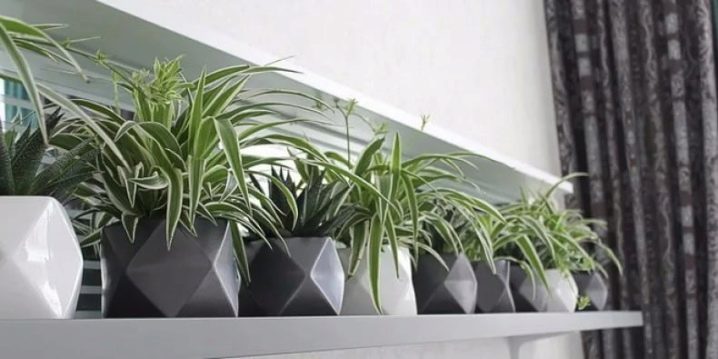


Watering
Chlorophytum loves full watering 2-3 times a week, while you should pay attention to the dryness of the earthen coma, it should be moderately moist, not dry out, but not turn into a swamp. In a dry room, it is advisable to periodically spray, so the leaves will retain their beauty
In a dry room, it is advisable to periodically spray it, so the leaves will retain their beauty.
In summer, watering should be more abundant, in winter, moderate, but without allowing the land to dry out completely
It is important to take into account the humidity in the room and the proximity to radiators.
In dry air, chlorophytum requires more frequent watering and spraying, otherwise the tips of the leaves will begin to dry.
Possible growing problems and diseases
Chlorophytum crested almost never gets sick, and it is rarely affected by pests. But sometimes unfavorable conditions can worsen the appearance of the plant or slow down its growth.
Picture 9 This wonderful flower practically does not get sick
The most common changes that occur are:
- The color of the leaf plate fades. This can happen when the plant is constantly exposed to direct sunlight. To solve the problem is simple - you need to rearrange the pot in a less illuminated place with diffused light. The color will be restored and the new leaves will already have a normal appearance.
- The tips of the leaves dry out. The reason for such changes is either a lack of moisture in the soil, or excessive dryness of the air. Sometimes a lack of nutrients can cause similar problems. In such a situation, the damaged parts of the leaves should be cut off, the regime of spraying and dressing should be adjusted. If there is no improvement, you can resort to a transplant.
- The leaves turn yellow and fall off. If this is observed in individual leaves of an adult plant, then, most likely, the process is natural and there is no threat. The massive yellowing of foliage, its wilting and dying off, most likely occurs from waterlogging of the soil. In this case, the damaged parts are cut and watering is reduced.
These are the most common problems that can arise when growing chlorophytum. Phenomena such as dropping flowers or massive leaf abscission are not observed in a flower.
Parasites can damage the plant, although this is rare in chlorophytum. If such a problem is found, the flower is isolated from other plants and treated with insecticides.
Chlorophytum crested is one of the easiest indoor plants to grow. He needs a minimum amount of care and attention. This flower will not only decorate the house, but also help to make the air cleaner.
It is especially worth paying attention to crested chlorophytum for novice growers, because caring for this plant at home will help to learn the basics of growing indoor flowers
Useful properties of crested chlorophytum
One of the beneficial properties of Crested Chlorophytum is its ability to reduce indoor air pollution in the form of formaldehyde, and about 70 flower bushes will eliminate or neutralize formaldehyde production in energy efficient homes. We recommend leaving it in the kitchen, where carbon monoxide is most likely to accumulate.
Scientists believe that in 24 hours a flower is able to destroy up to 70-80 percent of harmful microorganisms in its vicinity. Based on this, they argue that Crested Chlorophytum is absolutely necessary in a children's room. An adult plant is capable of destroying harmful microbes in an area of about two square meters, so the flower effect is truly impressive.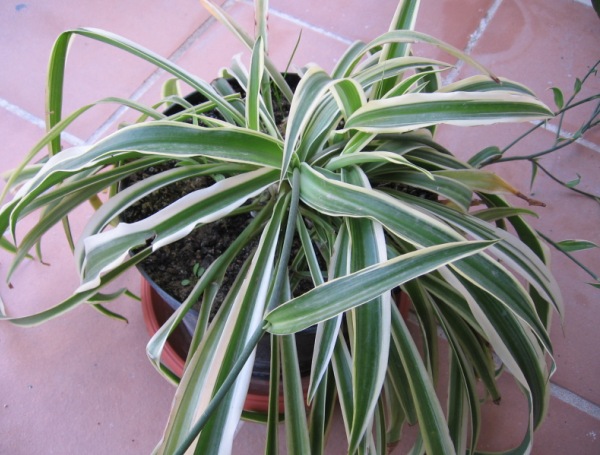
If you have not forgotten yet, the plant is native to the subtropics and tropics of South America and Africa, which means that the plant is perfectly able to retain moisture. This is another of the beneficial properties of Crested Chlorophytum. That is, the more you water the plant, the more moisture it releases into the surrounding atmosphere. And if you add activated carbon, then the level of moisture released will approximately double. Thus, the plant will be very useful for people with various lung diseases.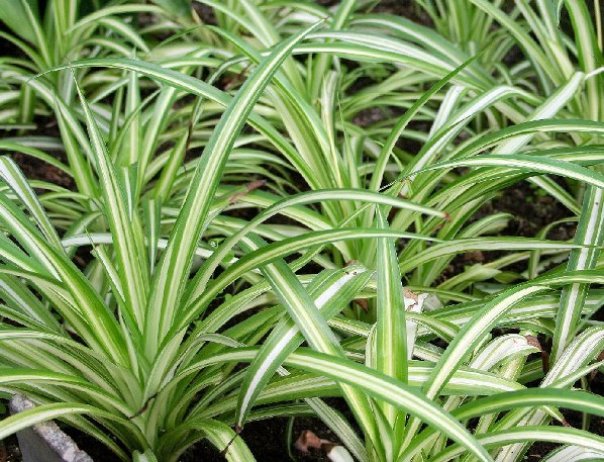
The flower is great for those who live near industrial and polluted areas, close to the roadway, as well as those who constantly suffer from allergies or frequent viral diseases.
Previously, the plant was used for medicinal purposes, especially for pregnant women as an amulet to protect mother and child. The bush was left in the room where they lived. The roots of chlorophytum crested were dipped into water, which the mother drank later to protect the child, as was previously believed. It was also administered to the child as a laxative tincture.

